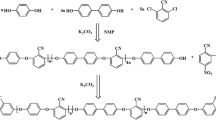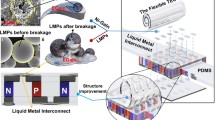Abstract
Flexible copper clad laminate has been used to fabricate flexible electronics such as bio-inspired tactile sensor, microfluidics-based sensor, and flexible printed circuits board. Herein, the effects of thermal property difference between the component layers on the residual interfacial deformation in a flexible copper clad laminate occurring during roll-to-roll composite film manufacturing were analyzed. The thermal behaviors of polyimide film and copper meshes in the laminate were examined, and it was found that differences of the coefficient of thermal expansion and elastic modulus between the two components could cause the residual deformation in the laminate. The three factors affecting the residual strain due to the thermal characteristic difference, i.e., temperature and pressure of the lamination roll and web tension, were selected in the controllable operating conditions in a roll-to-roll lamination process. Mathematical models to estimate the elastic and thermal residual strains according to the factors were developed and experimentally verified. Finally, the effects of the three factors on the residual strain in the laminate were determined using the developed model. In this study, we demonstrate that, in the lamination process, the thermal strain of the laminate component materials after thermal cycling generates a significant residual deformation, which causes defects in the flexible copper clad laminate. The developed model can be used to accurately estimate the residual elastic and thermal residual strains occurring during the roll-to-roll manufacturing according to the process conditions.




Similar content being viewed by others
References
Liu, Y., Shang, S., Mo, S., Wang, P., & Wang, H. (2020). Eco-friendly strategies for the material and fabrication of wearable sensors. International Journal of Precision Engineering and Manufacturing-Green Technology, 2020, 1–24.
Jo, M., Lee, J., Kim, S., Cho, G., Lee, T., & Lee, C. (2020). Web unevenness due to thermal deformation in roll–to–roll manufacturing process. Applied Sciences, 10(23), 8636.
Huang, R., Zhang, X., Ng, B. P., Kumar, A. S., & Liu, K. (2019). Roll-to-roll embossing of optical radial Fresnel lenses on polymer film for concentrator photovoltaics: a feasibility study. International Journal of Precision Engineering and Manufacturing-Green Technology, 2019, 1–12.
Hiltunen, J., Liedert, C., Hiltunen, M., Huttunen, M., Hiitola-Keinänen, J., Aikio, S., Harjanne, M., Kurkinen, M., Hakalahti, L., & Lee, L. P. (2018). Roll-to-roll fabrication of integrated PDMS–paper microfluidics for nucleic acid amplification. Lab on a Chip, 18, 1552–1559.
Zhang, X., Liu, K., Sunappan, V., & Shan, X. (2015). Diamond micro engraving of gravure roller mould for roll-to-roll printing of fine line electronics. Journal of Materials Processing Technology, 225, 337–346.
Lee, J., Kim, S., & Lee, C. (2019). Large area electrolyte coating through surface and interface engineering in roll-to-roll slot-die coating process. Journal of Industrial and Engineering Chemistry, 76, 443–449.
Kim, S., Lee, J., Jo, M., & Lee, C. (2020). Numerical modeling of ink widening and coating gap in roll-to-roll slot-die coating of solid oxide fuel cell electrolytic layer. Polymers, 12(12), 2927.
Lee, J., Kim, S., & Lee, C. (2019). Taper tension profile in roll-to-roll rewinder: improving adhesive force of pressure-sensitive adhesive film. International Journal of Precision Engineering and Manufacturing-Green Technology, 6(5), 853–860.
Seo, M., Lee, J. Y., Rha, J. J., Kim, M., & Lee, M. (2020). Mass printing of colored natural patterns on Al plate by roll imprinting and thin film deposition. Journal of Materials Processing Technology, 278, 116502.
Abouhamzeh, M., Sinke, J., Jansen, K. M. B., & Benedictus, R. (2015). Closed form expression for residual stresses and warpage during cure of composite laminates. Composite Structures, 133, 902–910.
Zhang, J. T., et al. (2016). Residual stresses created during curing of a polymer matrix composite using a viscoelastic model. Composites Science and Technology, 130, 20–27.
Santos, R. L., Silva, F. S., Nascimento, R. M., Motta, F. V., Souza, J. C., & Henriques, B. (2016). On the mechanical properties and microstructure of zirconia-reinforced feldspar-based porcelain. Ceramics International, 42(12), 14214–14221.
Ali, S., Tan, C., Waqas, M., Lv, W., Wei, Z., Wu, S., Goodenough, J. B., et al. (2018). Highly efficient PVDF-HFP/colloidal alumina composite separator for high-temperature lithium-ion batteries. Advanced Materials Interfaces, 5(5), 1701147.
Shen, K., Wan, S., Mo, Y. L., & Jiang, Z. (2018). Theoretical analysis on full torsional behavior of RC beams strengthened with FRP materials. Composite Structures, 183, 347–357.
Li, Z., Zhao, J., Jia, F., Zhang, Q., Liang, X., Jiao, S., & Jiang, Z. (2018). Analysis of bending characteristics of bimetal steel composite. International Journal of Mechanical Sciences, 148, 272–283.
Pan, F., Wang, G., Liu, L., Chen, Y., Zhang, Z., & Shi, X. (2019). Bending induced interlayer shearing, rippling and kink buckling of multilayered graphene sheets. Journal of the Mechanics and Physics of Solids, 122, 340–363.
Cao, H., Xiong, D. B., Tan, Z., Fan, G., Li, Z., Guo, Q., Zhang, D., et al. (2019). Thermal properties of in situ grown graphene reinforced copper matrix laminated composites. Journal of Alloys and Compounds, 771, 228–237.
Ji, X., Li, X., Yu, H., Zhang, W., & Dong, H. (2019). Study on the carbon nanotubes reinforced nanocomposite coatings. Diamond and Related Materials, 91, 247–254.
dos Reis Araújo, M., Hotza, D., Janssen, R., & Acchar, W. (2019). Processing and properties of tape-cast alumina/zirconia laminates composites. Journal of the European Ceramic Society, 39(12), 3462–3465.
Schneider, A., Farneda, R., Link, T., Martínez, J. I. F., Schmauder, J., & Harney, R. (2016). Impact of Ribbon Specification and Handling during PV Module Manufacturing to Module Reliability. In 32nd European Photovoltaic Solar Energy Conference and Exhibition. Munich, Germany (pp. 1583–1588).
Lee, J., Park, S., Park, J., Cho, Y. S., Shin, K. H., & Lee, D. (2015). Analysis of adhesion strength of laminated copper layers in roll-to-roll lamination process. International Journal of Precision Engineering and Manufacturing, 16(9), 2013–2020.
Rosen, B. W., & Hashin, Z. (1970). Effective thermal expansion coefficients and specific heats of composite materials. International Journal of Engineering Science, 8(2), 157–173.
Saif, M. T. A., Zhang, S., Haque, A., & Hsia, K. J. (2002). Effect of native Al2O3 on the elastic response of nanoscale Al films. Acta Materialia, 50(11), 2779–2786.
Rahman, M. M., & Netravali, A. N. (2018). Advanced Green composites using liquid crystalline cellulose fibers and waxy maize starch based resin. Composites Science and Technology, 162, 110–116.
Timofeev, V. B., Popov, V. I., Nikolaev, D. V., Timofeeva, T. E., & Smagulova, S. A. (2017). Preparation of transparent conducting films from CVD graphene by lamination and their characterization. Nanotechnologies in Russia, 12(1–2), 62–65.
Liu, P., Cottrill, A. L., Kozawa, D., Koman, V. B., Parviz, D., Liu, A. T., Strano, M. S., et al. (2018). Emerging trends in 2D nanotechnology that are redefining our understanding of “Nanocomposites.” Nano Today, 21, 18–40.
Acknowledgements
This work was supported by the National Research Foundation of Korea (NRF) grant funded by the Korea government(MSIT) (no. 2020R1A2C 1012428).
Author information
Authors and Affiliations
Corresponding author
Ethics declarations
Conflict of interest
This manuscript has not been published or presented elsewhere in part or in entirety and is not under consideration by another journal. All the authors have approved the manuscript and agree with submission to your esteemed journal. There are no conflicts of interest to declare.
Additional information
Publisher's Note
Springer Nature remains neutral with regard to jurisdictional claims in published maps and institutional affiliations.
Rights and permissions
About this article
Cite this article
Lee, C., Kim, S., Jo, M. et al. Residual Interfacial Deformation in Flexible Copper Clad Laminate Occurring During Roll-to-Roll Composite Film Manufacturing. Int. J. of Precis. Eng. and Manuf.-Green Tech. 8, 805–815 (2021). https://doi.org/10.1007/s40684-021-00349-0
Received:
Revised:
Accepted:
Published:
Issue Date:
DOI: https://doi.org/10.1007/s40684-021-00349-0




